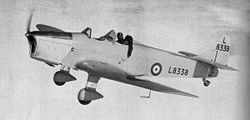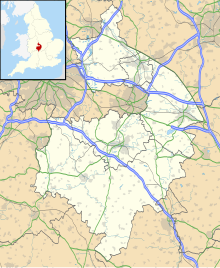| RAF Snitterfield | |||
|---|---|---|---|

| |||
| A Miles Magister similar to the ones that flew from the airfield | |||
| IATA: none – ICAO: none | |||
| Summary | |||
| Airport type | Military | ||
| Operator | Royal Air Force | ||
| Location | Snitterfield | ||
| Built | 1942 | ||
| In use | 1943-1946 | ||
| Elevation AMSL | 381 ft / 116 m | ||
| Coordinates | 52°14′14″N 001°43′08″W / 52.23722°N 1.71889°W | ||
| Map | |||
| Location in Warwickshire | |||
| Runways | |||
| Direction | Length | Surface | |
| ft | m | ||
| 02/20 | 5,744 | 1,750 | Concrete |
| 08/26 | 3,710 | 1,131 | Concrete |
| 14/32 | 3,862 | 1,177 | Concrete |
| [1] | |||
RAF Snitterfield is a former Royal Air Force station located west of Snitterfield, Warwickshire, England, 3.3 miles (5.3 km) north of Stratford-upon-Avon and 4.6 miles (7.4 km) south-east of Henley-in-Arden, Warwickshire.
Snitterfield was operational during the Second World War, the airfield was a class A airfield and had around 30 aircraft dispersals. The airfield was finished around June 1942 and cost around £1,147,000[2] and opened in 1943 then closed in 1946.[3]
Posted units[]
No.18 (Pilots) Advanced Flying Unit ((P)AFU) was the first unit to operate from the airfield starting on 7 May 1943 at RAF Church Lawford and using Snitterfield as a satellite airfield to disperse the aircraft as Church Lawford was very busy. On 3 April 1945 the unit moved permanently to RAF Snitterfield using Airspeed Oxfords and Miles Magisters.[3]
The airfield was also home to two Belgian training schools firstly the Initial Training School dealing with reception and training elements from 1 January 1944 until 13 December 1944[4] and secondly the Technical Training School from January 1944 until October 1946.[3]
From May 1945 to 1946, Snitterfield was used as a Relief Landing Ground by No. 20 Service Flying Training School from RAF Church Lawford.[1]
The airfield was also host to other units including:
- 1533 Flt Beam Approach Training Flight which joined in 1944 flying the Airspeed Oxford left 3 April 1945.[4]
- No 21 FTS flying the Harvard joined the airfield on 3 April 1945 until 18 September 1946.[4]
Accidents and incidents[]
During life as a RAF training base accidents were not far away with a number of airmen killed during training and within the surrounding area.
| Date | Incident | Reference |
|---|---|---|
| 1 September 1942 | Bristol Beaufighter X7943 YD-P of No. 255 Squadron RAF dived into the ground during an electrical storm. | [5] |
| 14 February 1944 | Vickers Wellington HZ110 of 22 OTU was diverted to the airfield in bad weather, where the bomber crashed after seven attempts to land. | [6] |
| 10 July 1944 | Airspeed Oxford NM278 of 18 PAFU made a violent recovery from a diving turn, causing the wings to break away. | [6] |
| 25 July 1944 | Wellington HF610 of 22 OTU belly landed. | [6] |
| 26 August 1944 | Miles Magister T9895 of 18 PAFU crashed on landing. | [6] |
Motor sports usage[]
In 1948, RAF Snitterfield was one of two disused airfields given special consideration as to the suitability of hosting a British Grand Prix. In the end, RAF Silverstone was chosen as the venue.[7]
Current use[]
The north-east section of the airfield is currently the Stratford Oaks Golf club and the south-east section is home to Stratford-Upon-Avon Gliding Club.[8] However before these were built there was a Wireless Transmission station.[9]
At the southern end of the airfield is now Stratford Armouries[10] which is a military museum that was built in 2007.[11]
References[]
Citations[]
- ↑ 1.0 1.1 "RAF Snitterfield". Control Towers. http://www.controltowers.co.uk/S/Snitterfield.htm. Retrieved 27 April 2012.
- ↑ "RAF Worksop - World War II". Priories Historical Society - RAF Worksop Memorial. http://rafworksop.btck.co.uk/BaseHistory/WorldWarII. Retrieved 27 April 2012.
- ↑ 3.0 3.1 3.2 "RAF Snitterfield". Air of Authority - A History of RAF Organisation. http://www.rafweb.org/Stations/Stations-S.htm#Snitterfield. Retrieved 27 April 2012.
- ↑ 4.0 4.1 4.2 "Military flying units in the south west Midlands". Aviation Archaeology. http://www.aviationarchaeology.org.uk/marg/flying_units.htm. Retrieved 27 April 2012.
- ↑ "Military aircraft crashes in the south west Midlands - 1942". Aviation Archaeology. http://www.aviationarchaeology.org.uk/marg/crashes1942.htm. Retrieved 27 April 2012.
- ↑ 6.0 6.1 6.2 6.3 "Military aircraft crashes in the south west Midlands - 1944". Aviation Archaeology. http://www.aviationarchaeology.org.uk/marg/crashes1944.htm. Retrieved 27 April 2012.
- ↑ Swinger 2001, p. 119.
- ↑ "Snitterfield". Airfields of Britain Conservation Trust. http://www.abct.org.uk/airfields/snitterfield. Retrieved 27 April 2012.
- ↑ "HF Radio - Bearley". Alan Cordwell Web Portal. http://www.alancordwell.co.uk/hfradio/bearley.html. Retrieved 27 April 2012.
- ↑ "Wellington Museum". Stratford Armouries. http://www.stratfordarmouries.com/index.php?option=com_content&view=article&id=48&Itemid=54. Retrieved 27 April 2012.
- ↑ "News". A.I Architecture. http://www.aiarchitecture.co.uk/archived_news.html. Retrieved 27 April 2012.
Bibliography[]
- Swinger, P.S. Motor racing Circuits in England, Then & Now. Ian Allan Publishing, 2001. ISBN 978-0711027961.
External links[]
| ||||||||||||||||||||||||||||||||
The original article can be found at RAF Snitterfield and the edit history here.

